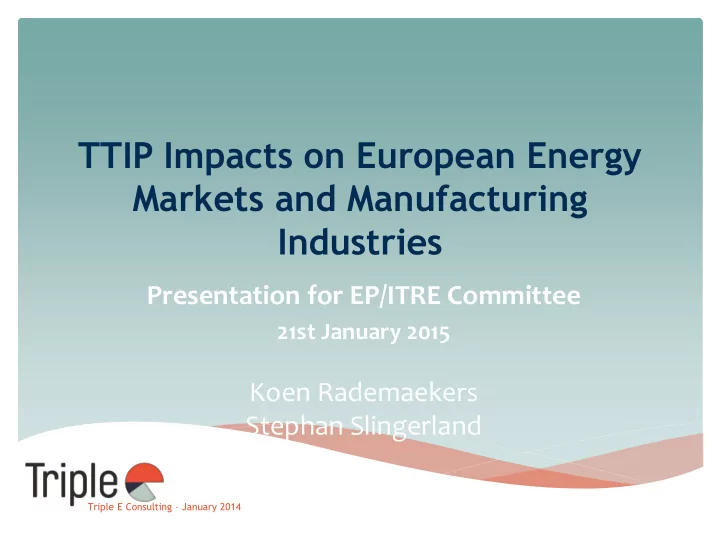

TTIP Impacts on European Energy Markets and Manufacturing Industries Presentation for EP/ITRE Committee 21st January 2015 Koen Rademaekers Stephan Slingerland Triple E Consulting – January 2014
This Presentation EU – US Trade Relations and TTIP Potential impacts on the energy sector Potential impacts on the manufacturing sector Conclusions and recommendations
EU – US Trade Relations
EU – US Trade Direction of Goods Services Investment trade (2013) (2012) (2012) (bln € ) EU to US 282 163 1,655 US to EU 196 149 1,536 Trade balance + 92 + 14 + € 119 EU Source: Eurostat A positive trade balance for the EU
TTIP Negotiation Process Ongoing since 2013 Seven rounds so far 23 topics Negotiation areas Market access Services and investment Regulatory issues Sectoral annexes
Potential Impacts on the Energy Sector
EU – US Energy Commodities Trade EU-27 - US trade by SITC (2013) per ton (Source: Eurostat) Commodity EU Imports EU Exports 103,285,142 8 Coal 1,231 24,314 Briquettes, Lignite and Peat 199,066 6,874 Coke and Semi coke Petroleum oil and oils obtained from bituminous 17,905,931 22,054,330 minerals, other than crude (refined) Petroleum oil and oils obtained from bituminous 4,843 3,173,598 minerals, crude (cf. ban on US crude oil exports) 16,145 4 Waste oils 5,954,695 466,022 Residual petroleum products Liquified propane and butane 1,484,660 1,819 497,697 33 Natural Gas, whether or not liquefied 4,917 32,552 Petroleum gases and other gaseous hydrocarbons It is clear where the trade is...
Tariff and Non-Tariff Barriers for Energy Source: WTO Tariff data Fuel type Non-tariff measure EU tariff US tariff (%) (0%) Oil (US) Export ban - License Required 0 > 0.2% Natural gas (US) Export ban - License Required 0 0 (EU) Fuel quality directive (FQD) 0 > 0.4 Refined fuels (gasoline, diesel) Coal (EU/US) Climate policy 0 0 Solar cells (tech) (EU/US) Local content 0 0 requirement 2.7 1.25 Wind energy (EU/US) Local content (tech) requirement Tariffs are low, but significant non-tariff barriers exist
Impact on Energy Trade Coal is already without tariffs Export bans to be affected by TTIP? Other barriers (climate policies, FQD) not directly affected LNG trade to increase, but more interesting markets in Asia Limited TTIP impacts on energy trade expected
Impact on Energy Security ... If export bans are removed... ... If LNG trade to Europe will become attractive... ... If a crisis mechanism is agreed on (separately)... Then TTIP could have a positive impact on energy security in the EU
Impact on Renewables Through the removal of local content requirements (LCR) .... trade in renewable energy technologies is likely to increase We expect possibilities for harmonisation without lowering env. standards (for ex Ecodesign)
Potential Impacts on the Manufacturing Sector
Tariff Measures Trade weighted average tariff rates (%) (2007) EU Agriculture, forestry and fisheries US Other primary sectors Processed foods Chemicals Electrical machinery Motor vehicles Other transport equipment Other machinery Metals and metal products Wood and paper products Other manufactures % 0 2 4 6 8 10 12 14 16 Source: CEPR. 2013 Tariff barriers are generally low, with some exceptions
Non-Tariff Measures Ad valorem equivalents of NTM in the U.S. and EU (%) (2007) Foods and beverages Chemicals US Electrical machinery EU Motor vehicles Other transport equipment Metals and metal products Wood and paper products Personal, cultural, other services Constructions Communications Business and ICT Insurance Banking Transportation 0 10 20 30 40 50 60 70 80 Source: CEPR, 2013 Almost 80% of the benefits of the TTIP are expected to come from the removal of NTMs
Overall impacts Depend on scenario All scenarios show (limited) positive impacts on GDP TTIP might lead to positive spill-overs in increased trade with third countries and adoption of standards Small changes in emissions only
Impacts on specific sectors Changes in EU output by 2027 (%) Ambitious Motor vehicles Less ambitious Other manufactures Processed foods Other machinery Chemicals Wood and paper products Other transport equipment Metals and metal production Electrical machinery -8 -6 -4 -2 0 2 Source: CEPR 2013 EU Metals and Electrical machinery are likely to decrease outputs
TTIP benefits will not be equal for all Member States Changes in Real Per Capita Income of Selected Countries (%) Source: Felbermayr et al. 2014 Core EU countries do not profit more than perifery
Labour market impacts Depend on specific provisions or on additional agreements Competitiveness: Lower US labour and energy costs stand against skills, energy efficiency, innovation Relatively low movement of workers across sectors due to TTIP Overall labour market impacts expected to be low
Impacts on Innovation In particular companies with high R&D costs can profit from access to larger markets Intellectual Property Rights and in particular Geographical Indicators could be at risk Contribution of TTIP to longer-term re-industrialisation and greening of industry is unclear There are likely to be some benefits for innovation, but relation of TTIP to EU long-term policy goals is unclear
Policy Recommendations
Main Conclusions Energy Security of supply, trade and energy prices might be less affected than claimed Renewables might benefit from TTIP via removal of Local Content Requirements Manufacturing industry A small positive impact for most EU manufacturing industries is expected, with large uncertainties Innovation might be stimulated Labour market effects likely to be limited
Recommendations Monitor Monitor closely if benefits of TTIP outweigh drawbacks of watering down on EU legislation (e.g. REACH, FQD) Follow-up on the implications of ISDS in relation to TTIP Discuss Further discuss the relationship between TTIP and longer- term EU objectives regarding greening of industry Analyse Re-estimate TTIP projections once draft texts have become public
Thank you for your attention Triple E Consulting – January 2013
ISDS Mechanism Investor-state dispute settlement (ISDS) mechanism in the TTIP is currently under debate – however very controversial ISDS was introduced in the Treaty of Lisbon and currently used under the provisions of the Energy Charter Treaty (ECT) (with 80% of the EU cases) If included in TTIP, environmental policies might be disputed by international energy companies where they have made investments
Recommend
More recommend